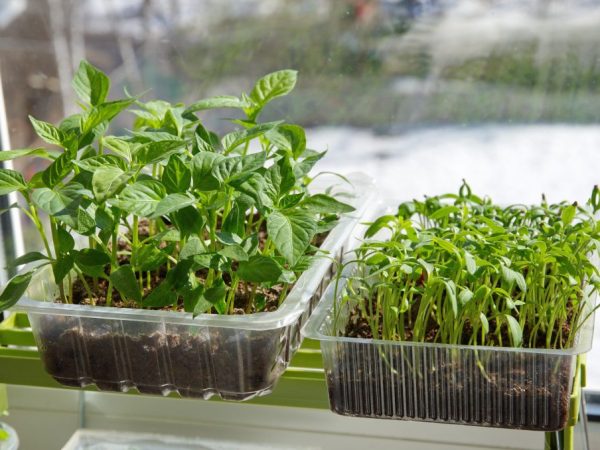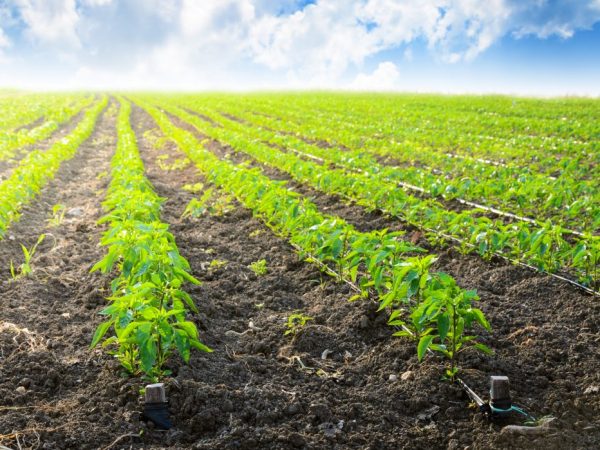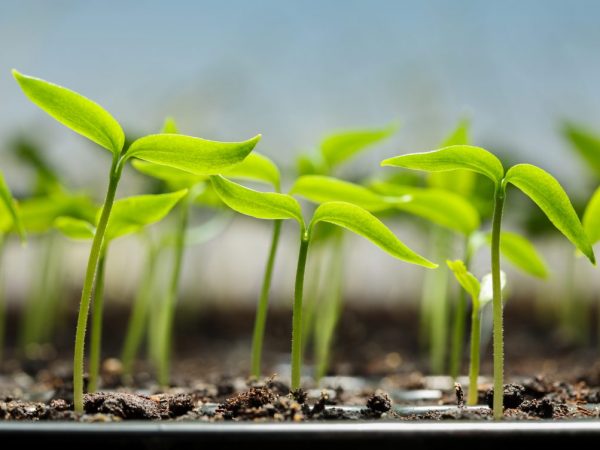Pepper planting rules in Siberia
Siberia is a region of risky farming. But this does not prevent many vegetable growers from successfully planting and growing such a heat-loving culture as pepper. The key to successful cultivation in Siberia is the right time for sowing seeds and the correct planting of pepper. To correctly determine the timing of sowing and planting, it is best to focus on the climatic conditions of the region and the duration of the growing season and fruiting of peppers.

Pepper planting rules in Siberia
When and how to sow seeds
Warm weather in Siberia is established not earlier than mid-May. Relatively warm weather lasts no more than three months, and during this period the temperature can often drop below 20 ° C during the day and below 15 ° C at night. And pepper actively grows at temperatures above 22 ° C, with fluctuations and decreases, growth stops, and the time of fruiting is postponed.
For this region, pepper can only be grown by seedlings. You need to plant seeds long before planting in the garden. With the seedling method, the growing season of peppers can be divided into the following conditional periods:
- from sowing seeds to planting seedlings - 60-70 days;
- from planting to the garden to the first ovary - 30 days;
- from the beginning of the mass ovary to harvest - 30-40 days.
It is important to focus on these features when sowing seeds. You should not rush to sow pepper seeds, because until the soil warms up to 16-18 ° C, seedlings cannot be planted in the ground. This can significantly weaken and sometimes destroy the plants. And the overgrown seedlings at home are very difficult to take root in a new place and painfully endure a transplant.
The optimal time to plant peppers for seedlings in Siberia will be early-mid March, if planting in unheated greenhouses is planned. But if it is planned to grow bell peppers in the open field, then we sow the seeds in the 20th of March. It is advisable to sow pepper in February only if it will grow in a heated greenhouse.
Sowing according to the lunar calendar
When growing pepper, you can focus on the dates indicated in the sowing calendar. Such a calendar is based on the phases of the moon. Plants that form fruit in the aerial part should be sown during the waxing moon. Favorable days for sowing pepper:
- February - 17-22,24-28 days;
- March - 1,18,19,20,21,22,23,25-30 days;
- April - 17-20.
For planting seedlings in the soil, favorable dates are also distinguished in the calendar: May 18,19,27,28.
Sowing seeds

Choose varieties specifically for Siberia
Having determined the optimal time for sowing pepper for seedlings in Siberia and choosing the right varieties, it is important to carefully approach the process of sowing seeds, care and growing seedlings.
In order for the seedlings to grow well, you need to choose the right soil mixture, process it and prepare the seeds for sowing. For young plants, the soil mixture should be nutritious and well-drained.It is good to let the water pass through, not letting it stagnate, but partially retain it and do not dry out instantly. You can buy a special potting soil mixture for vegetables or prepare the soil yourself. For this you will need:
- sod land;
- peat;
- river sand.
These components are mixed in a 3: 2: 1 ratio. The prepared soil must be disinfected. This can be done using a solution of potassium permanganate (1 g per 1 liter of water) or peroxide (1 tbsp. L. Per 1 liter of water), any of the proposed solutions spill the soil and let it dry well.
Seed preparation
Pepper seeds must be disinfected before sowing. This procedure is done using a solution of potassium permanganate or phytosporin. A 1% solution of potassium permanganate is prepared and in it for 20-25 minutes. soak the seeds. Then it is washed with clean water and dried. You can use the biofungicide phytosporin, add a few drops of the drug to 1 liter of water and soak the seeds for 30 minutes. Sow the treated seeds no later than 24 hours after the procedure. Often seeds purchased in the store are already processed, this is indicated on the package, and they have a colored coating, they do not need to be disinfected. We sow the processed seeds directly into the prepared soil without any additional treatments.
To speed up the germination process, the planting material is practiced to soak. For this, the seeds are spread on moistened cotton wool or cheesecloth, and covered. Put in a place with a temperature of 25-28 C. Leave for 3-4 days for swelling or until sprouts appear, make sure that they do not dry out, sprinkle with warm water from a spray bottle.
Planting seeds
We sow the prepared seeds in containers filled with soil. They are carefully laid out on pre-moistened soil at a distance of 2-2.5 cm from each other. After that, sprinkle with earth 1-1.5 cm and cover with a film. Crops are placed in the most luminous warm place. It is important to remember that the optimum temperature for the emergence of pepper shoots is 24-28 C. At this temperature, the first seedlings germinate in 7-10 days.
Seedling care
When friendly shoots appeared, the film is gradually removed. To ensure the full growth of seedlings, it is important to monitor the following factors:
- watering;
- temperature;
- lighting;
- seating.

Proper watering and lighting is required
Watering
Peppers at the seedling stage need sufficient watering. The frequency and amount of water required will depend on the room temperature and the volume of soil in which the seedlings are growing. At temperatures above 24 C, watering is carried out every morning. At the initial stage, this is done with a syringe, a teaspoon. Water should penetrate 3-4 cm deep into the soil. The lower the temperature, the less watering is done.
Temperature
After the emergence of seedlings, if there is such an opportunity, it is recommended to lower the temperature to 16-18 C for 4-5 days, this will prevent the seedlings from pulling out. In subsequent times, the optimum temperature should be maintained at 22-28 C, with a possible decrease at night by several degrees.
Lighting
It is very important for the development of pepper to maintain 12 hours of daylight hours, this ensures proper development, prevents the stems from stretching and thinning. Young plants are illuminated with fluorescent lamps or phytolamps. On cloudy days, the lamps are used throughout the day, on sunny days they turn on the sutra for several hours and in the evening.
Seating
When the seedlings grow two or three true leaves, it is better to plant them in separate containers. For this, plastic glasses and peat pots with a volume of 250-330 ml or any other pots are suitable, from which, when transplanted to a permanent place, it will be easy to get plants without injuring the root system. The containers are filled with soil, a depression is made in the middle and spilled with water. The seedlings are carefully removed together with the earthen lump with a spoon or garden spatula and carefully transplanted without deepening.Peppers do not tend to form lateral roots on the stems, so deepening during transplanting can lead to decay.
After picking, the plants are shaded for 3-4 days from direct sunlight, and watering is resumed after 4 days.
Seedling planting rules
It is necessary to plant seedlings in a permanent place after 60-70 days from the moment of their emergence. This coincides with the time of the appearance of the first peduncles on a young bush. But in order for the transplant to be safe, warm weather should be established for the plants, and the soil should warm up to 16-18 C. In Siberia, this time rarely comes before 20 May. At the end of May, the weather stabilizes, the possibility of night frosts has already been reduced to a minimum, and the daytime temperature drops are not so sharp. Seedlings are planted in the greenhouse a week or two earlier than in open ground, but also only when the ground is sufficiently warmed up.
Seedling hardening
Two weeks before planting, young bushes are hardened, for this they are taken out onto the street or balcony. The residence time is increasing every day. This will help the seedlings better cope with temperature changes after planting in the garden.
Warming up the beds
Agronomists and gardeners of Siberia recommend to warm up the beds when growing peppers. For this, horse manure, plastic or glass bottles filled with water or natural stones are used.
- Manure has the ability to warm the soil for a long time during cold snaps. For heating purposes, a ditch with a depth of 25-30 cm is made in the aisles, manure is laid in it with a calculation of 3 kg / sq. m. Pour boiling water to start the process of heat release and cover with removed earth.
- The bottles are filled with water and evenly laid out on the surface of the garden. In the daytime, under the sun's rays, they will heat up, and at night, when the temperature of the air and soil decreases, they will give off their heat and warm the soil.
- Natural stones are used in the same way as bottles. They will be heated during the day, and at night they will give the necessary heat to the beds.
For planting, planting holes are prepared, at a distance optimal for each individual variety. On average, one sq. m plant 3-4 bushes. A handful of onion husks and 1 tbsp are placed in the holes. l. wood ash, this will protect the seedlings from pests and will serve as top dressing. The hole is spilled with water a couple of hours before planting the seedlings.
Transplant process
Plants are carefully removed from the pots without destroying the earthy clod and planted. During planting, make sure that the root does not bend, but lies flat or in a circle. Seedlings are not buried, the root collar should be at surface level. Sprinkle with loose soil in half and watered when the water has been absorbed, cover the rest of the earth and lightly press the soil near the stem.
After planting near the trunk circle, mulch with compost, peat or straw. If the temperature still fluctuates and may drop below 15 C, then it is advised to cover the freshly planted pepper in open beds with a white non-woven material, it will protect the seedlings from the cold, but will let in sunlight.
Conclusion
In such an agronomically difficult area for growing heat-loving vegetables as Siberia, it is possible to achieve good results if the timing of sowing and planting is observed. Hopefully our recommendations can help you get a bountiful and healthy harvest.

